Intel Core i7 4960X (Ivy Bridge E) Review
by Anand Lal Shimpi on September 3, 2013 4:10 AM EST- Posted in
- CPUs
- Intel
- Ivy Bridge
- Ivy Bridge-E
Video Transcoding
With our lightly threaded tests behind us, it's time to move to more CPU intensive pastures.
We migrated to the latest verison of the x264 HD benchmark which features a much newer version of x264 and a much heavier workload. The focus here is on quality rather than speed, thus the benchmark uses a 2-pass encode and reports the average frame rate in each pass.
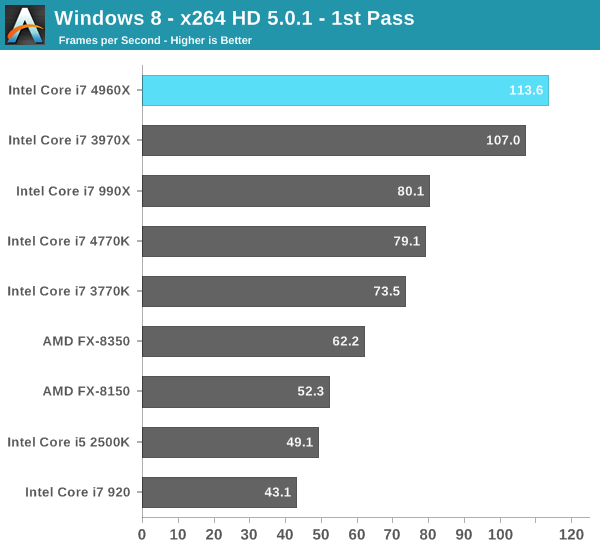

Here we see all of the 6-core parts rise to the top, including Intel's old Gulftown based Core i7-990X. Despite being a few years old at this point, the 990X's 6-core design and relatively high clock speed gives it better performance here than the quad-core Haswell 4770K.
The 4960X manages to be around 30% faster than the old 990X, and is 40% faster than the 4770K. For heavily threaded applications, there's simply no replacement for more cores.
Just like I did earlier, I dusted off one of our really old x264 tests so we'd have comparison data to even older CPUs including the Pentium 4 and Penryn based Extreme Edition parts:
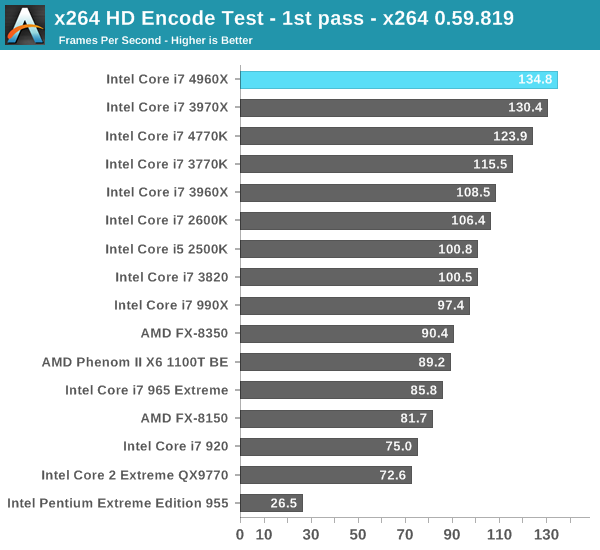
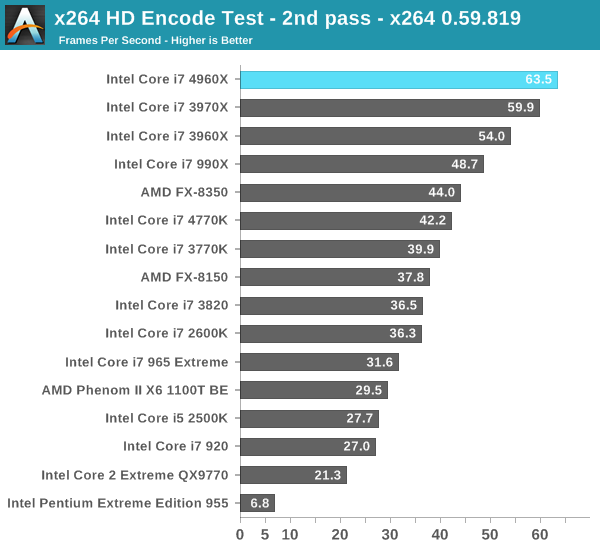
The 4960X manages to deliver nearly 3x the performance of Intel's flagship from 6 years ago. The Pentium EE 955 comparison is even more insane. IVB-E is basically an order of magnitude faster than the last high-end Pentium 4s to come out of Intel back in 2005.
3D Rendering
Our new POV-Ray benchmark uses the latest beta binary (3.7RC6) and runs through both single and multithreaded versions of the popular raytracing benchmark.
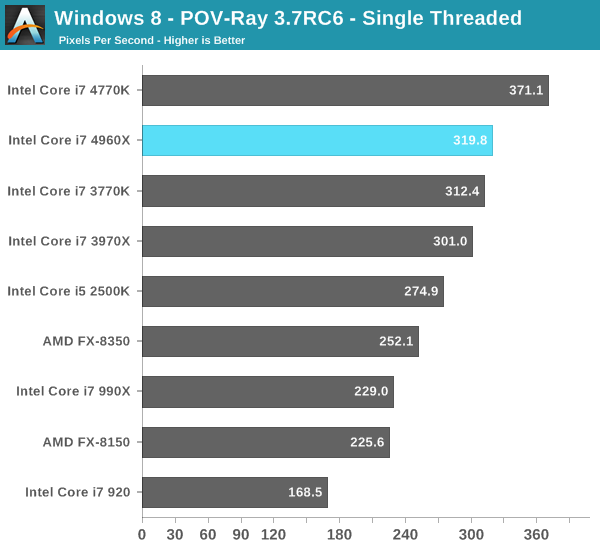
Isolating a single core shows us exactly what we're missing by having Ivy Bridge at the heart of the 4960X instead of Haswell. Here the 4770K manages a 16% performance advantage over the 4960X, which costs 3x as much and draws substantially more power. Looking at AMD's FX-8350 however it's clear why Intel can get away with launching a high-end 6-core chip without its latest cores. Piledriver's single threaded performance falls somewhere between Nehalem and Sandy Bridge, giving Intel room to launch another Ivy Bridge based high-end SKU in 2013 and get away with it.
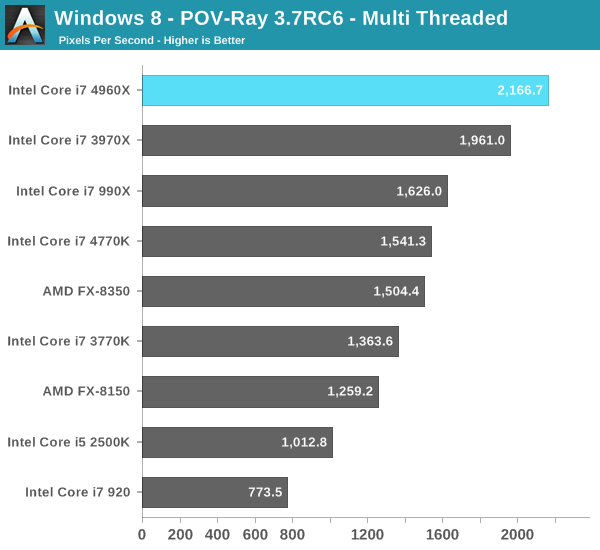
The multithreaded performance story is very different. Here even the Gulftown based 990X is faster than Haswell thanks to its six cores. The 4960X is 40% faster than the Haswell based 4770K. Even AMD's FX-8350 does really well here, basically equalling Haswell's performance.
Created by the Cinema 4D folks we have Cinebench, a popular 3D rendering benchmark that gives us both single and multi-threaded 3D rendering results.
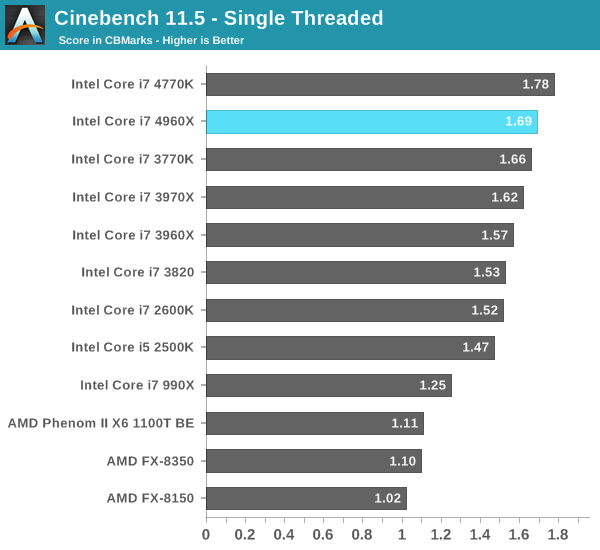
In Cinebench, the single threaded Haswell/IVB-E gap narrows to 5%.
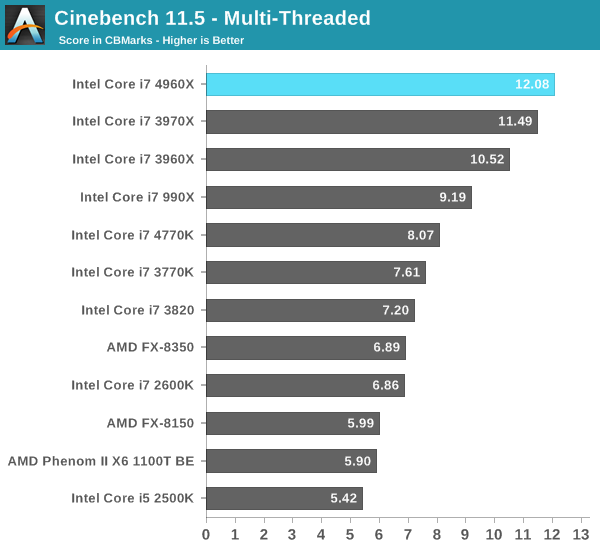
Multithreaded performance continues to be just stellar. Here the 4960X is just under 50% faster than the 4770K. Note the relatively small gap between the 4960X and the SNB-E based 3970X however - the performance gain is only 5%. The bulk of Ivy Bridge's advancements were in GPU performance (not applicable to IVB-E) and power consumption (which we'll get to shortly).
Our final two Cinebench tests use the R10 benchmark to enable a comparison to more/older data points:
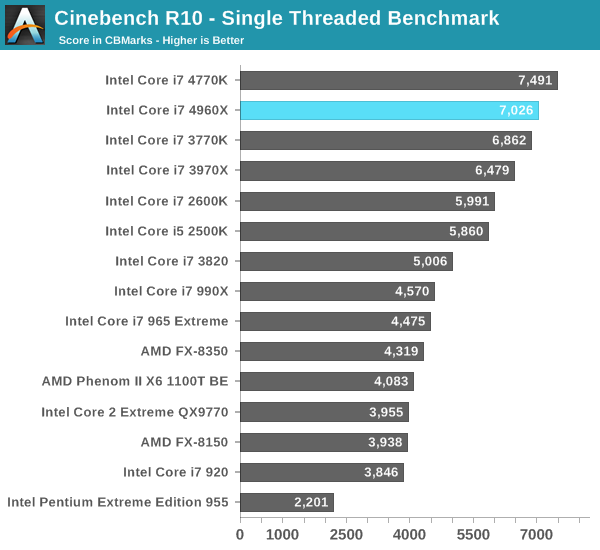
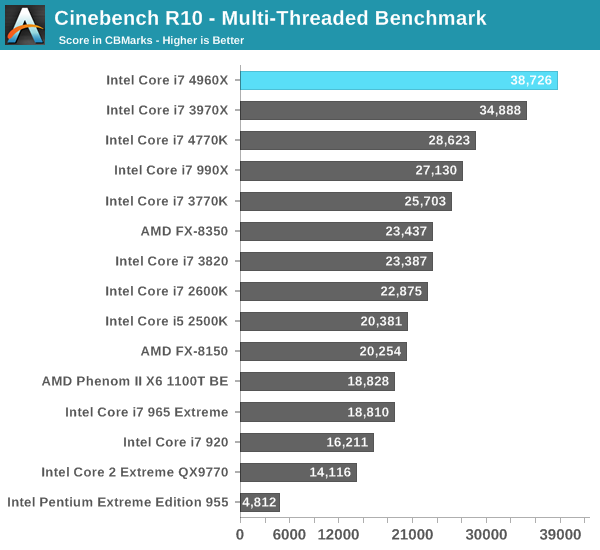










120 Comments
View All Comments
Snoopykins - Tuesday, September 3, 2013 - link
Excellent review. I must say the reviews Anand himself writes always seem to be spot on. One question, where does the 22 months number come from? Is that the scheduled/rumored/leaked release date of Haswell-E? If so, isn't that going to be even more behind than Ivy-E? I'm assuming Skylake will have been out for longer than Haswell has been out now, no? Also, do we know that Skylake will support DDR4? I've heard Haswell-E will.Anywho, thanks for the excellent review, I thoroughly enjoyed it.
eiriklf - Tuesday, September 3, 2013 - link
22 months is about the time between the releases of sandy bridge extreme and ivy bridge extreme1Angelreloaded - Tuesday, September 3, 2013 - link
Haswell-e will if they move to a new socket and board DDR4 probably won't be compatible with DDR3 DIMM sockets.hrrmph - Tuesday, September 3, 2013 - link
Yep, that was a great review.It's not often that I think that a review really nails it all (at least for what I need), but this one did it. Very balanced, taking shots at the weak points, while also thoroughly explaining what is good about it, and who it might benefit.
X79 is adequate only if you are willing to load your machine up with lots of add-in controller cards.
Intel will really need to up their game on the chipset when Haswell-E gets here.
jasonelmore - Tuesday, September 3, 2013 - link
most modern x79 boards have all the add on controllers soldered onto the motherboard. Cards are not needed.just4U - Friday, September 6, 2013 - link
With so few new things coming out in the desktop division these days Im sure Anand is quite fine to getting back into the trenches to do the odd review. Used to be (or so it seemed) every other day we were getting glimpses at exciting new things but these days that appears in the form of tablets and smartphones /w the desktop industry being somewhat stagnant in my opinion.dishayu - Tuesday, September 3, 2013 - link
At this rate, as Anand suggests, Haswell-E will come out around/after Skylake based Desktop parts(assuming that is still on track for 2015 release). I am convinced that it would have been a better approach to skip Haswell-E altogether and jump straight to Skylake-E in 2015. This logic is further supported by the fact that next gen will require a new socket design (since Haswell comes with FIVR).jasonelmore - Tuesday, September 3, 2013 - link
there is still a node jump to go through. Most of the time this delays projected release dates. Broadwell may be late.Kevin G - Wednesday, September 4, 2013 - link
Since there is going to be a Haswell refresh in 2014, I'd expect Haswell-E to be introduced around the same time: roughly a year from now. The delay of Broadwell on the desktop will allow Haswell-E to catch up in cadence a bit.The new question is when Broadwell-E will arrive: with Skylake or vanilla Broadwell on the desktop?
f0d - Tuesday, September 3, 2013 - link
nice cpu for those that have an older platform (like 1156 or 1366 maybe) but as someone that already owns a 2011 socket cpu im still hoping they will eventually release 8 or even 10/12 core cpu's so i can encode vids fastercmon intel release those 8/10/12 core cpu's for the enthusiast platform.!